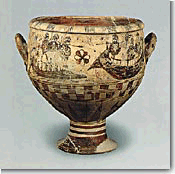

In Thucydides' work there is the information that once all the inhabitants of islands were pirates (Histories 1.5,7-8). He probably refers to the end of the
Piracy was already known since the Minoan times (Thucydides, Histories 1.4). Especially the Cretans were reputed as extremely efficient in sea raids. The method used to carry out their piratic attacks created the characteristic type of the Cretan pirate, as this is described in Homer's works. Throughout the Archaic period, Cretan pirates continued to ply the Mediterranean in quest of capture. Around the middle of the Classical period, the pirates of Cilicia prevailed against the Cretans thus restricting their activity.
The inhabitants of Aegina were known in the Archaic world for their aptitude in the "art" of piracy. When Herodotus refers to their independence, he explains it as the result of piratic raids against Epidaurus (Historia 5.83.1-7). Since early times they were involved in them, thus dominating the coasts of Peloponnese, even before they travelled to Naucratis in Egypt and to other harbours. Furthermore, the geographical position of the island allowed the control of ships' passage in the Saronic Gulf. They engaged especially in abducting unfortunate travellers, whom they sold as slaves, since this sort of merchandise was quite lucrative. There are references to the abduction of tyrant Pisistratus' daughter by some suitor and her being sold as slave in Aegina. It is very likely that by the end of the |
 |
|
| |
|
Note: Click on a picture for a brief description. | |